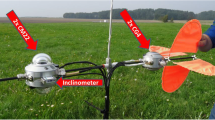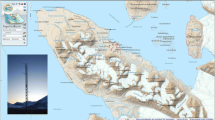Abstract
Radiosonde measurements obtained at the Arctic site Ny-Ålesund (78.9°N, 11.9°E), Svalbard, from 1993 to 2014 have been homogenized accounting for instrumentation discontinuities by correcting known errors in the manufacturer provided profiles. The resulting homogenized radiosonde record is provided as supplementary material at http://doi.pangaea.de/10.1594/PANGAEA.845373. From the homogenized data record, the first Ny-Ålesund upper-air climatology of wind, temperature and humidity is presented, forming the background for the analysis of changes during the 22-year period. Particularly during the winter season, a strong increase in atmospheric temperature and humidity is observed, with a significant warming of the free troposphere in January and February up to 3 K per decade. This winter warming is even more pronounced in the boundary layer below 1 km, presumably amplified by mesoscale processes including e.g. orographic effects or the boundary layer capping inversion. Though the largest contribution to the increasing atmospheric water vapour column in winter originates from the lowermost 2 km, no increase in the contribution by specific humidity inversions is detected. Instead, we find an increase in the humidity content of the large-scale background humidity profiles. At the same time, the tropospheric flow in winter is found to occur less frequent from northerly directions and to the same amount more frequent from the South. We conclude that changes in the atmospheric circulation lead to an enhanced advection of warm and moist air from lower latitudes to the Svalbard region in the winter season, causing the warming and moistening of the atmospheric column above Ny-Ålesund, and link the observations to changes in the Arctic Oscillation.

















Similar content being viewed by others
References
Beszczynska-Möller A, Fahrbach E, Schauer U, Hansen E (2012) Variability in Atlantic water temperature and transport at the entrance to the Arctic Ocean, 1997–2010. ICES J Mar Sci 69:852–863. doi:10.1093/icesjms/fss056
Beine HJ, Argentini S, Maurizi A, Mastrantonio G, Viola A (2001) The local wind field at Ny-Ålesund and the Zeppelin mountain at Svalbard. Meteorog Atmos Phys 78:107–113. doi:10.1007/s007030170009
Bintanja R, Graversen RG, Hazeleger W (2011) Arctic wintertime amplified by the thermal inversion and consequent low infrared cooling to space. Nat Geosci 4:758–761. doi:10.1038/NGEO1285
Bodeker GE, Bojinski S, Cimini D, Dirksen RJ, Haeffelin M, Hannigan JW, Hurst DF, Leblanc T, Madonna F, Maturilli M, Mikalsen A, Philipona R, Reale T, Seidel DJ, Tan DGH, Thorne PW, Vömel H, Wang J (2016) Reference upper- air observations for climate: from concept to reality. Bull Am Meteorol Soc 97(1):123–135. doi:10.1175/BAMS-D-14-00072.1
Chylek P, Folland CK, Lesins G, Dubey MK, Wang M (2009) Arctic air temperature change amplification and the Atlantic multidecadal oscillation. Geophys Res Lett 36:L14801. doi:10.1029/2009GL038777
Curry JA, Schramm JL, Serreze MC, Ebert EE (1995) Water vapour feedback over the Arctic Ocean. J Geophys Res 100:14223–14229. doi:10.1029/95JD00824
Dai A, Wang A, Thorne PW, Parker DE, Haimberger L, Wang X (2011) A new approach to homogenize daily radiosonde humidity data. J Clim 24:965–991. doi:10.1175/2010JCLI3816.1
Devasthale A, Sedlar J, Tjernström M (2011) Characteristics of water-vapour inversions observed over the Arctic by Atmospheric Infrared Sounder (AIRS) and radiosondes. Atmos Chem Phys 11:9813–9823. doi:10.5194/acp-11-9813-2011
Dirksen RJ, Sommer M, Immler FJ, Hurst DF, Kivi R, Vömel H (2014) Reference quality upper-air measurements; GRUAN data processing for the Vaisala RS92 radiosonde. Atmos Meas Tech 7:4463–4490. doi:10.5194/amt-7-4463-2014
Doyle JG, Lesins G, Thackray CP, Perro C, Nott GJ, Duck TJ, Damoah R, Drummond JR (2011) Water vapour intrusions into the high Arctic during winter. Geophys Res Lett 38:L12806. doi:10.1029/2011GL047493
Durre I, Vose RS, Wuertz DB (2006) Overview of the integrated global radiosonde archive. J Clim 19:53–68. doi:10.1175/JCLI3594.1
Elliott WP, Gaffen DJ (1991) On the utility of radiosonde humidity archives for climate studies. Bull Am Meteorol Soc 72:1507–1520. doi:10.1175/1520-0477(1991)072<1507:OTUORH>2.0.CO;2
Esau I, Ripina I (2012) Wind climate in Kongsfjorden, Svalbard, and attribution of leading wind driving mechanisms through turbulence-resolving simulations. Adv Meteorol ID568454. doi:10.1155/2012/568454
Francis JA, Hunter E (2006) New insight into the disappearing Arctic sea ice. EOS Trans Am Geophys Union 87:509–511
Gaffen DJ (1994) Temporal inhomogeneities in radiosonde temperature records. J Geophys Res 99:3667–3676. doi:10.1029/93JD03179
Graversen RG, Mauritsen T, Tjernström M, Källén E, Svensson G (2008) Vertical structure of recent Arctic warming. Nature 451:53–56. doi:10.1038/nature06502
Gruber C, Haimberger L (2008) On the homogeneity of radiosonde wind time series. Meteorol Z 17:631–643. doi:10.1127/0941-2948/2008/0298
Hannachi A, Jolliffe IT, Stephenson DB (2007) Empirical orthogonal functions and related techniques in atmospheric science: a review. Int J Climatol 27:1119–1152. doi:10.1002/joc.1499
Hansen J, Nazarenko L (2004) Soot climate forcing via snow and ice albedos. Proc Natl Acad Sci U S A 101:423–428. doi:10.1073/pnas.2237157100
Hare FK (1960) The summer circulation of the arctic stratosphere below 30 km. Q J R Meteorol Soc 86:127–143
Hyland RW, Wexler A (1983) Formulations for the thermodynamic properties of the saturated phases of H2O from 173.15 K to 473.15 K. ASHRAE Trans 89(2 A):500–519
Kahl JD (1990) Characteristics of the low-level temperature inversion along the Alaskan Arctic Coast. Int J Climatol 10:537–548. doi:10.1002/joc.3370100509
Kivi R, Kujanpää J, Aulamo O, Hassinen S, Heikkinen P, Calbet X, Montagner F, Vömel H (2009) Observations of water vapor profiles over Northern Finland by satellite and balloon borne instruments. Proceedings of the 2009 EUMETSAT Meteorological Satellite Conference, EUMETSAT P.55, ISSN 1011-3932.
Lanzante JR (1996) Resistant, robust and non-parametric techniques for the analysis of climate data: theory and examples including applications to historical radiosonde station data. Int J Climatol 16:1197–1226. doi:10.1002/(SICI)1097-0088(199611)16:11<1197::AID-JOC89>3.0.CO;2-L
Marks AA, King MD (2013) The effects of additional black carbon on the albedo of Arctic sea ice: variation with sea ice type and snow cover. Cryosphere 7:1193–1204. doi:10.5194/tc-7-1193-2013
Massoli P, Maturilli M, Neuber R (2006) Climatology of Arctic polar stratospheric clouds as measured by lidar in Ny-Ålesund, Spitsbergen (79°N, 12°E). J Geophys Res 111:D09206. doi:10.1029/2005JD005840
Maturilli M, Neuber R, Massoli P, Cairo F, Adriani A, Moriconi ML, Di Donfrancesco G (2005) Differences in Arctic and Antarctic PSC occurrence as observed by lidar in Ny-Ålesund (79°N, 12°E) and McMurdo (78°S, 167°E). Atmos Chem Phys 5:2081–2090
Maturilli M, Herber A, König-Langlo G (2013) Climatology and time series of surface meteorology in Ny-Ålesund, Svalbard. Earth Syst Sci Data 5:155–163. doi:10.5194/essd-5-155-2013
Maturilli M, Herber A, König-Langlo G (2015) Surface radiation climatology for Ny-Ålesund, Svalbard (78.9°N), basic observations for trend detection. Theor Appl Climatol 120:331–339. doi:10.1007/s00704-014-1173-4
Miloshevich LM, Vömel H, Paukkunen A, Heymsfield AJ, Oltmans SJ (2001) Characterization and correction of relative humidity measurements from Vaisala RS80-A radiosondes at cold temperatures. J Atmos Ocean Technol 18:135–155
Miloshevich LM, Paukkunen A, Vömel H, Oltmans S (2004) Development and validation of a time-lag correction for Vaisala radiosonde humidity measurements. J Atmos Ocean Technol 21:1305–1327. doi:10.1175/1520-0426(2004)021<1305:DAVOAT>2.0.CO;2
Moradi I, Soden B, Ferraro R, Arkin P, Vömel H (2013) Assessing the quality of humidity measurements from global operational radiosonde sensors. J Geophys Res 118:8040–8053. doi:10.1002/jgrd.50589
Nygård T, Valkonen T, Vihma T (2014) Characteristics of Arctic low-tropospheric humidity inversions based on radio soundings. Atmos Chem Phys 14:1959–1971. doi:10.5194/acp-14-1959-2014
Ohmura A (2001) Physical basis for the temperature-based melt-index method. J Appl Meteorol 40:753–761. doi:10.1175/1520-0450(2001)040<0753:PBFTTB>2.0.CO;2
Overland JE, Wang M, Salo S (2008) The recent Arctic warm period. Tellus A 60:589–597. doi:10.1111/j.1600-0870.2008.00327.x
Park DSR, Lee S, Feldstein SB (2015) Attribution oft he recent winter sea ice decline over the Atlantic sector of the Arctic Ocean. J Clim 28:4027–4033. doi:10.1175/JCLI-D-15-0042.1
Preisendorfer RW (1988) Principal component analysis in meteorology and oceanography. In: Developments in atmospheric science, vol 17. Elsevier, Amsterdam
Rojo M, Claud C, Mallet PE, Noer G, Carleton AM, Vicomte M (2015) Polar low tracks over the Nordic Seas: a 14-winter climate analysis. Tellus A 67:24660. doi:10.3402/tellusa.v67.24660
Scherhag R (1952) Die explosionsartige Stratosphärenerwärmung des Spätwinters 1951/52. Ber Deut Wetterdienst 38:51–63
Schweiger AJ, Lindsay RW, Vavrus S, Francis JA (2008) Relationships between Arctic sea ice and clouds during autumn. J Clim 21:4799–4810. doi:10.1175/2008JCLI2156.1
Screen JA, Simmonds I (2010) The central role of diminishing sea ice retreat in recent Arctic temperature amplification. Nature 464:1334–1337. doi:10.1038/nature09051
Sedlar J, Tjerström M (2009) Stratiform cloud - inversion characterization during the Arctic melt season. Bound-Layer Meteorol 132:455–474. doi:10.1007/s10546-009-9407-1
Sedlar J, Shupe MD, Tjernström M (2012) On the relationship between thermodynamic structure and cloud top, and its climate significance in the Arctic. J Clim 25:2374–2393. doi:10.1175/JCLI-D-11-00186.1
Serreze MC, Barrett AP, Stroeve JC, Kindig DN, Holland MM (2009) The emergence of surface-based Arctic amplification. Cryosphere 3:11–19. doi:10.5194/tc-3-11-2009
Serreze MC, Barry RG (2011) Processes and impacts of Arctic amplification: a research synthesis. Glob Planet Chang 77:85–96
Serreze MC, Barrett AP, Cassano JJ (2011) Circulation and surface controls on the lower tropospheric air temperature field of the Arctic. J Geophys Res 116:D07104. doi:10.1029/2010JD015127
Shindell D, Faluvegi G (2009) Climate response to regional radiative forcing during the twentieth century. Nat Geosci 2:294–300. doi:10.1038/NGEO473
Shupe MD, Intrieri JM (2004) Cloud radiative forcing of the Arctic surface: the influence of cloud properties, surface albedo, and solar zenith angle. J Clim 17:616–628. doi:10.1175/1520-0442(2004)017<0616:CRFOTA>2.0.CO;2
Soden BJ, Lanzante RL (1996) An assessment of satellite and radiosonde climatologies of upper-tropospheric water vapor. J Clim 9:1235–1250. doi:10.1175/1520-0442(1996)009<1235:AAOSAR>2.0.CO;2
Solomon A, Shupe MD, Persson POG, Morrison H (2011) Moisture and dynamical interactions maintaining decoupled Arctic mixed-phase stratocumulus in the presence of a humidity inversion. Atmos Chem Phys 11:10127–10148. doi:10.5194/acp-11-10127-2011
Thompson DWJ, Wallace JM (1998) The Arctic Oscillation signature in the wintertime geopotential height and temperature fields. Geophys Res Lett 25:1297–1300
Treffeisen R, Krejci R, Ström J, Engvali AC, Herber A, Thomason L (2007) Humidity observations in the Arctic troposphere over Ny-Ålesund, Svalbard based on 15 years of radiosonde data. Atmos Chem Phys 7:2721–2732. doi:10.5194/acp-7-2721-2007
Vihma T, Kilpeläinen T, Manninen M, Sjöblom A, Jakobson E, Palo T, Jaagus J, Maturilli M (2011) Characteristics of temperature and humidity inversions and low-level jets over Svalbard fjords in spring. Adv Meteorol 2011:ID486807. doi:10.1155/2011/486807
Wang J, Cole HL, Carlson DJ, Miller ER, Beierle K (2002) Corrections of humidity measurement errors from the Vaisala RS80 radiosonde–application to TOGA COARE data. J Atmos Ocean Technol 19:981–1002. doi:10.1175/1520-0426(2002)019<0981:COHMEF>2.0.CO;2
Woods C, Caballero R (2016) The role of moist intrusions in winter Arctic warming and sea ice decline. J Clim. doi:10.1175/JCLI-D-15-0773.1
World Meteorological Organization (1957) Meteorology—a three dimensional science. WMO Bull 6:134–138
Zängl G, Hoinka KP (2001) The tropopause in the polar regions. J Clim 14:3117–3139
Zhang Y, Seidel DJ (2011) Challenges in estimating trends in Arctic surface‐based inversions from radiosonde data. Geophys Res Lett 38:L17806. doi:10.1029/2011GL048728
Acknowledgments
The authors would like to thank the overwintering staff of the AWIPEV research base (former Koldewey station) in Ny-Ålesund for the devoted launches of thousands of radiosondes contributing to this study. Special thanks to Jürgen Graeser, Siegrid Debatin and Holger Deckelmann for technical hard- and software support. We also thank the GRUAN Lead Centre for reprocessing early Ny-Ålesund RS92 radiosonde data. Furthermore, we thank Sabine Erxleben and Dörthe Handorf for calculating AO patterns and indices and for helpful discussions during the review process. We thank the reviewers for their helpful comments.
Author information
Authors and Affiliations
Corresponding author
Rights and permissions
About this article
Cite this article
Maturilli, M., Kayser, M. Arctic warming, moisture increase and circulation changes observed in the Ny-Ålesund homogenized radiosonde record. Theor Appl Climatol 130, 1–17 (2017). https://doi.org/10.1007/s00704-016-1864-0
Received:
Accepted:
Published:
Issue Date:
DOI: https://doi.org/10.1007/s00704-016-1864-0




